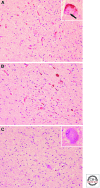Parkinson's disease and parkinsonism: neuropathology
- PMID: 22908195
- PMCID: PMC3405828
- DOI: 10.1101/cshperspect.a009258
Parkinson's disease and parkinsonism: neuropathology
Abstract
Parkinsonism, the clinical term for a disorder with prominent bradykinesia and variable associated extrapyramidal signs and symptoms, is accompanied by degeneration of the nigrostriatal dopaminergic system, with neuronal loss and reactive gliosis in the substantia nigra found at autopsy. Parkinsonism is pathologically heterogeneous, with the most common pathologic substrates related to abnormalities in the presynaptic protein α-synuclein or the microtubule binding protein tau. In idiopathic Parkinson's disease (PD), α-synuclein accumulates in neuronal perikarya (Lewy bodies) and neuronal processes (Lewy neurites). The disease process is multifocal and involves select central nervous system neurons and peripheral autonomic nervous system neurons. The particular set of neurons affected determines nonmotor clinical presentations. Multiple system atrophy (MSA) is the other major α-synucleinopathy. It is also associated with autonomic dysfunction and in some cases with cerebellar signs. The hallmark histopathologic feature of MSA is accumulation of α-synuclein within glial cytoplasmic inclusions (GCI). The most common of the Parkinsonian tauopathies is progressive supranuclear palsy (PSP), which is clinically associated with severe postural instability leading to early falls. The tau pathology of PSP also affects both neurons and glia. Given the population frequency of PD, α-synuclein pathology similar to that in PD, but not accompanied by neuronal loss, is relatively common (10% of people over 65 years of age) in neurologically normal individuals, leading to proposed staging schemes for PD progression. Although MSA-like and PSP-like pathology can be detected in neurologically normal individuals, such cases are too infrequent to permit assessment of patterns of disease progression.
Figures





References
-
- Abbott RD, Petrovitch H, White LR, Masaki KH, Tanner CM, Curb JD, Grandinetti A, Blanchette PL, Popper JS, Ross GW 2001. Frequency of bowel movements and the future risk of Parkinson’s disease. Neurology 57: 456–462 - PubMed
-
- Berendse HW, Booij J, Francot CM, Bergmans PL, Hijman R, Stoof JC, Wolters EC 2001. Subclinical dopaminergic dysfunction in asymptomatic Parkinson’s disease patients’ relatives with a decreased sense of smell. Ann Neurol 50: 34–41 - PubMed
-
- Boeve BF, Maraganore DM, Parisi JE, Ahlskog JE, Graff-Radford N, Caselli RJ, Dickson DW, Kokmen E, Petersen RC 1999. Pathologic heterogeneity in clinically diagnosed corticobasal degeneration. Neurology 53: 795–800 - PubMed
Publication types
MeSH terms
Grants and funding
LinkOut - more resources
Full Text Sources
Other Literature Sources
Miscellaneous
